President Donald Trump was admitted to Walter Reed National Military Medical Center on Friday where he will stay over the next few days and receive treatment. While questions have been raised as why he wasn't being treated at the White House, which has the state-of-the-art facility for treating complicated illnesses, Walter Reed National Military Medical Center the nation's premier health-care center for troops and senior government officials.
Now that Trump has arrived at the hospital, he will stay in the hospital's designated Presidential Suite, a lavish portion of one of its 88 buildings. Although the White House said that Trump will be 'working' from the Presidential Suite during his stay, many believe that his hospitalization suggests the President is much sicker than official statements claim.
Well-Equipped Suite

A number of US Presidents have visited Walter Reed for years. In fact, the hospital was originally designed to provide medical care exclusively to military personnel and presidents. The Presidential Suite is known as Ward 71 and is one of six special patient rooms reserved for high-ranking military officers and members of the White House cabinet.
The suite is well armored with 'protective devices and communications gear used in support of the president,' wrote Rear Admiral Connie Mariano, who served as a physician to Presidents George H.W. Bush and Bill Clinton and as director of the White House Medical Unit. The suite has a dining room lit by a crystal chandelier, with a desk a few steps from the hospital bed. The other rooms are decked out with couches for receiving visitors as well as security technology.

Trump will be working from the suite, as said by the White House. However, it depends on his health as many speculate that he is quite unwell and won't be able to discharge his duties over the next several days. Former Defense Secretary Leon Panetta urged the White House to allow doctors treating Trump to address the country about his condition and care as it is extremely important to keep the public fully informed about what is happening to his health.
Every President's Choice
Not only Trump, even the First Lady Melania Trump was treated at Walter Reed for a kidney condition in 2018. Walter Reed, which is situated about nine miles from the White House, considers itself 'The Nation's Medical Center'. It has 7,100 staff members who are spread out across 100 clinics and specialties.
The hospital grew in popularity and became a talking point after it saved the life of former President Ronald Reagan after a 1985 assassination attempt.

Given that it serves the top leaders of the United States, the hospital is outfitted with a wing dedicated to visitors from the highest offices. Presidents and Vice Presidents are always treated at the Medical Evaluation and Treatment Unit (METU), which is secure, private and separate from the sprawling hospital's other wards.
Walter Reed General Hospital was inaugurated on May 1, 1909. World War I saw the hospital's capacity grow from 80 patient beds to 2,500 in a matter of months. It served American soldiers over the more than 100 years. Originally built in Washington, D.C., it finally moved out of the city and merged with the National Naval Medical Center (NNMC) in Bethesda in 2011.
Over the years, Walter Reed has served and cared for every president of the United States, members of Congress and the Supreme Court, and other leaders. The hospital also has 165 'Smart Suites' outfitted with 'two-way communication devices, audiovisual and wireless capabilities as well as bedside entertainment, all of which can be controlled via a wall-mounted, removable keyboard that the patient has access to at all times.'









